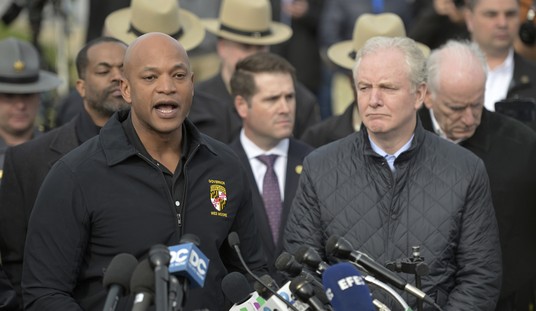“We’re going a bit in the wrong direction,” CNBC’s Rick Santelli observed this morning, but is that the real picture? The answer: It’s complicated.
The first problem is the metric itself, which isn’t really designed for the purpose for which it’s been used over the past year. Initial weekly jobless claims are based on state data that often gets rushed, and that data is dependent on unemployment-insurance bureaucracies that are notoriously slow and difficult. It makes for a decent long-range metric, but week-on-week, the results are too volatile for any reliable analysis.
In this case, even the trends look curious, though:
In the week ending April 3, the advance figure for seasonally adjusted initial claims was 744,000, an increase of 16,000 from the previous week’s revised level. The previous week’s level was revised up by 9,000 from 719,000 to 728,000. The 4-week moving average was 723,750, an increase of 2,500 from the previous week’s revised average. The previous week’s average was revised up by 2,250 from 719,000 to 721,250.
The advance seasonally adjusted insured unemployment rate was 2.6 percent for the week ending March 27, unchanged from the previous week’s revised rate. The previous week’s rate was revised down by 0.1 from 2.7 to 2.6 percent. The advance number for seasonally adjusted insured unemployment during the week ending March 27 was 3,734,000, a decrease of 16,000 from the previous week’s revised level. This is the lowest level for insured unemployment since March 21, 2020 when it was 3,094,000. The previous week’s level was revised down by 44,000 from 3,794,000 to 3,750,000. The 4-week moving average was 3,862,000, a decrease of 105,750 from the previous week’s revised average. The previous week’s average was revised down by 10,750 from 3,978,500 to 3,967,750.
Even the four-week average is ticking upward, at least slightly. That certainly flies in the face of expectations that two massive stimulus/relief packages passed within weeks of each other would kick-start jobs expansion in the US. Instead, the numbers have grown slightly — for which there may be at least one explanation.
CNBC’s Santelli expresses his surprise at the lack of impact here:
First-time claims for unemployment insurance rose more than expected last week despite other signs of healing in the jobs market, the Labor Department reported Thursday.
First-time claims for the week ended April 3 totaled 744,000, well above the expectation for 694,000 from economists surveyed by Dow Jones. The total represented an increase of 16,000 from the previous week’s upwardly revised 728,000. The four-week moving average edged higher to 723,750.
The news comes a week after a sign of more aggressive healing in the labor market, as nonfarm payrolls in March increased by 916,000 while the unemployment rate fell to 6%.
If I was to choose between the BLS monthly data and the Labor Department’s initial weekly jobless claims metric, I’d choose BLS as the better indicator of job-market conditions. It’s a more stable metric, and it’s based on two surveys with a long history of operation that make the trends more realistic. Those have their own shortcomings, but they cut out the state bureaucracies and get closer to the real source data — businesses and workers.
There may be another reason why the jobless claims keep coming, and it very well could be the stimulus package itself. It again extended pandemic-related unemployment benefits, including the bonus payments intended to help buffer the impacts of government-imposed restrictions on commerce. Critics have contended for months that they’re incentivizing people to avoid seeking jobs, and the data might support that:

Notice how both of the pandemic-related benefits programs grew in the week after the bill passed and went into effect. Even though the US added 916,000 jobs in March, claims on these benefits went up by 320,000 in a week. That could just be a momentary effect, but it correlatively suggests that the incentives provided by these programs might be encouraging people to take advantage of these programs rather than work for potentially lower rates while those benefits remain available. That’s not to suggest that people are looking for ways not to work, but incentives matter in economics — which is why government policy should set them properly in the first place.
Let’s look at this another way. We now have 13 million people on pandemic-related benefits programs, one year into the pandemic-related shutdowns and restrictions. According to BLS data, we are only 8.4 million jobs below our employment level from February 2020 (152.5 million then versus 144.1 million for March 2021). Some of those 13 million might be crossing over into both programs, but with the growth of 14 million jobs since April 2020, we should expect to see much smaller numbers in these pandemic categories. And once again, that calls into question whether these massive cash infusions through “emergency” programs are creating perverse incentives that are reflected in unemployment metrics such as initial weekly jobless claims.
At some point, we need to let these programs expire. We saw a very similar dynamic in 2009-10 with extended unemployment benefits, until House Republicans finally killed them in early 2011. What happened? Jobs started getting filled and the world failed to come to an end. Politically, Congress probably can’t stop these these benefits from flowing until the shutdowns and restrictions are all lifted, but that is likely to be at or before the end of the current appropriation. It will be time to end the perverse incentives and restore dynamism to the labor force … but it will take Republicans to stand firm and hold the line to do so.








